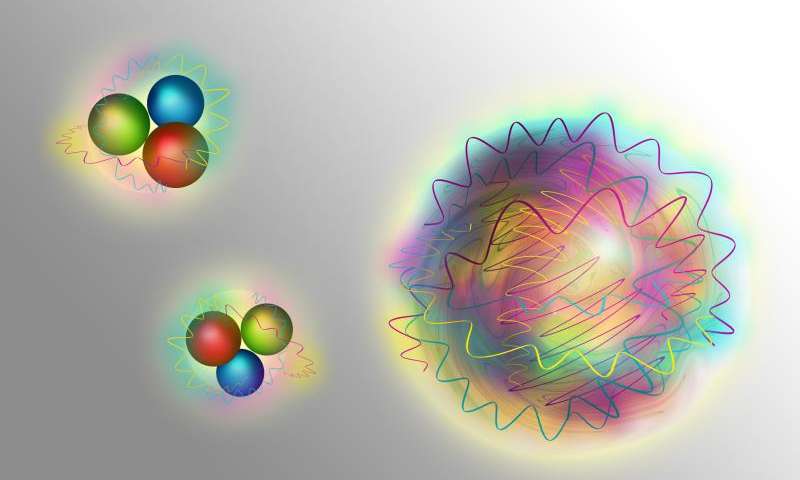Physicists announced the discovery of a particle consisting of gluons alone

Austrian nuclear physicists claim that in one of the reactions they managed to observe the hypothetical particle “ gluonium ” (glueball). Theorists predicted its existence in the framework of the Standard Model . Gluonium consists of gluons alone and does not contain quarks.
Quarks and gluons are the hypothetical particles that hadrons are made of. It is believed that they cannot be observed separately, they are always combined in any elementary particle. Physicists thought about the presence of common identical "bricks" in the structure of hadrons around the 1950s, when they realized that a fairly large number of elementary particles obtained by them in collisions exhibit common properties. Physicists decided that any hadron consists of three quarks.
However, these quarks behave rather strangely. For example, quarks cannot be separated (with increasing distance between them, their binding force also increases) and combined in an amount greater than three (except for the state of aggregation of a substance called " quark-gluon plasma ", in which, theoretically, quarks move freely throughout the clot).
In addition, if the nucleus of a heavier chemical element simply consists of a larger number of protons and neutrons, then heavier hadrons hypothetically consist of all of the same quarks that are simply combined in a different way. Changing the relative position of the quarks, we get another particle.
Subsequently, it was decided that the quark mass is not responsible for quarks (it is generally accepted that their mass is about two percent of the proton mass), but the “force field” that binds them together - gluons. They are the ones who endure the strong interaction. Changing the location of quarks, for example, moving them away from each other, we increase the gluon “cloud”, and it becomes more massive.
In further experiments, it was found that gluons are not at all passive carriers of the interaction between quarks, but they are also independent “partons” —bricks that make up hadrons. When studying a fast-flying proton, it became clear that about half of its energy is carried by quarks, and the other half by gluons.
The Austrians from the Vienna Institute of Technology are sure that the meson f0 (1710) is precisely that hypothetical gluonium. Although gluons themselves do not have mass, their interaction with each other gives rise to mass. As a result, gluonium can be observed, albeit by an indirect method, by observing particle decay.
The calculations of VTI professor Anton Rebhan and his student Frederic Brünner regarding gluon decay suspiciously coincided with the experiment in which the particle f0 (1710) participated. It remains to receive confirmation of this experiment.
“Unfortunately, the picture of the breakdown of gluonium cannot be calculated accurately,” complains Anton Reban. Simplified calculations have indicated that two mesons are suitable candidates for the mysterious particle - f0 (1500) and f0 (1710). The first always seemed to be a more suitable candidate, and the second, although it was better suited to computer calculations, during the decay gave a lot of heavy ("strange") quarks, which from the point of view of physicists did not seem plausible.
Austrian scientists used a different, non-standard approach in their calculations. “Our calculations showed that gluonium can actually break up into strange quarks,” writes Anton Reban. The calculated decay into two light particles was in good agreement with the observations of the decay f0 (1710). In addition, it turned out that it is possible to decay into a larger number of particles than two.
A few months later, experiments at the Large Hadron Collider and the Chinese accelerator BESIII (Beijing Electron-Positron Collider) should provide new data for analysis. They will be able to confirm or deny the results obtained by the Austrians.
